Imports from OPEC reduced to irrelevancy.
By Wolf Richter for WOLF STREET.
Production of US crude oil, including condensate, in May, at 11.2 million barrels per day, was still down 13% from the peak in late 2019 and back at July 2018 levels, according to EIA data released on Friday. What is fascinating – given how US production doubled over the past decade, reducing US imports from OPEC to nearly nothing (more on that in a moment), crushing the price of oil, and crushing in the process investors in the US oil sector – is how oil drillers in the US, and their battered investors, have refused to raise production back to 2019 levels, despite the recovery in the price of oil.
Production over the past six months was down 17.4% from production over the six months through March 2020.
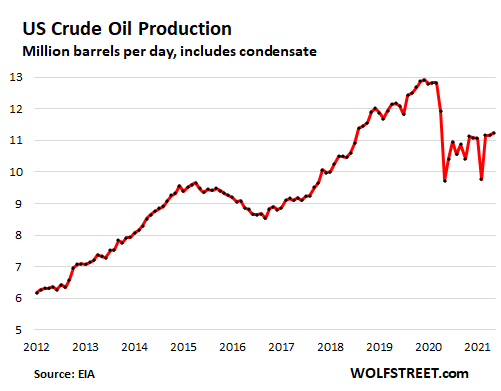
The price of oil recovers — partially.
The sudden plunge in production in the spring last year and the partial recovery since then looks very different from what transpired during the beginning of the Great American Oil Bust. Production began to fall in April 2015 and continued to fall gradually through September 2016, before starting to rise again. During that time, the price of oil collapsed, with West Texas Intermediate plunging from over $100 a barrel in mid-2014 to $26 a barrel in April 2016. And numerous oil field companies filed for bankruptcy.
The cutback in production this year – rumored to be due to the newly found “discipline” in the Oil Patch – has reduced overproduction in the US. The price of WTI futures, which had collapsed into the negative for a brief moment in April 2020 for the first time in history, has rocketed higher and has been trading mostly above $70 a barrel since early June ($71.42 at the moment):
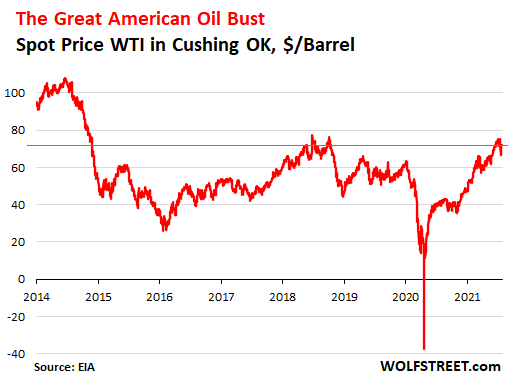
OPEC shoved aside.
Imports from OPEC started plunging as the fracking boom in the US took off. Back in mid-2008, the US was still importing over 5.5 million barrels per day from OPEC. By November 2020, imports from OPEC had collapsed to 0.5 million barrels per day. In May, imports from OPEC were 0.9 million barrels per day. This range is the lowest in the EIA data going back to 1973:
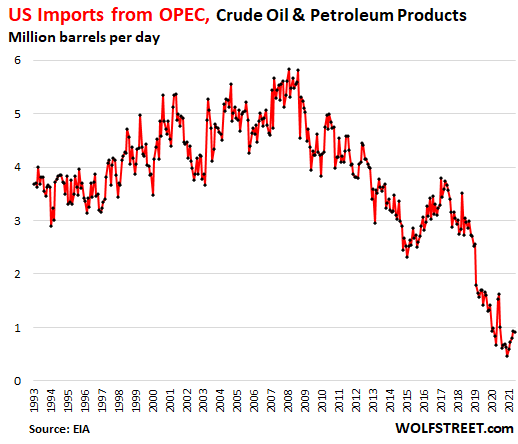
Exports of crude oil and petroleum products soared until they didn’t.
In late 2015, the US Congress lifted the export ban on US crude oil, as the price of crude oil was plunging. Before then, with the ban in effect, the US could export crude oil to certain countries and could export petroleum products globally. But in early 2016, the crude oil export valves were opened all the way, crude oil exports surged from less than 0.5 million barrels a day in 2015 to 3.7 million barrels per day in February 2020.
But since the plunge in early 2020, exports of crude oil have not really recovered (red line in the chart below).
Exports of the overall category of “crude oil and petroleum products” have been rising steadily with the fracking boom for over a decade, and reached 10 million barrels per day in February 2020. But after the plunge in early 2020, they have only partially recovered (purple line).
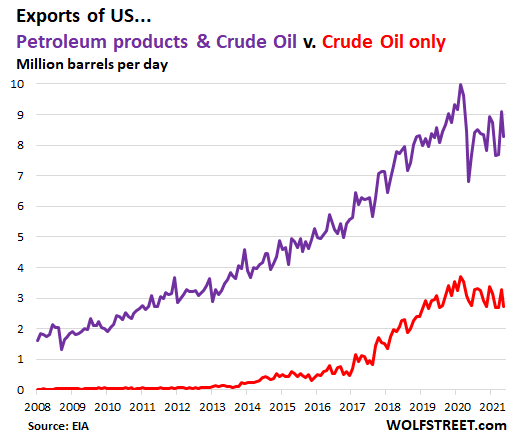
US now net exporter of “crude oil & petroleum products.”
Imports of overall crude oil and petroleum products, minus exports of these products, results in the “net imports.” This figure was positive for many decades, with net imports reaching a peak of over 13 million barrels a day in mid-2006.
It has since tumbled due to the surge in exports and the plunge in imports, and in October 2019, for the first time, the US exported more than imported. This trend has continued, and the US thereby has become a net exporter of “crude oil & petroleum products.”
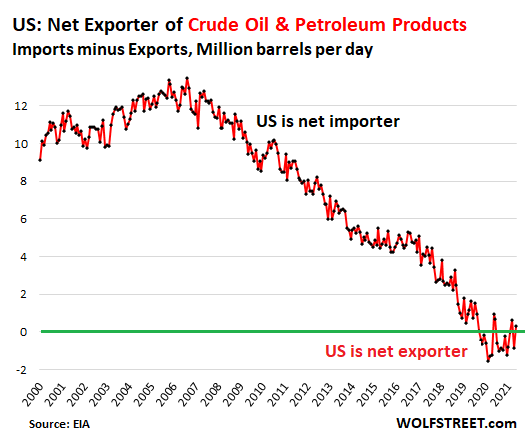
In terms of crude oil by itself, the US still imports more crude oil than it exports, but these net imports of crude oil have tumbled by over 70% from a peak of 10.5 million barrels a day in 2006 to a range of 2.1 – 3.1 million barrels per day:
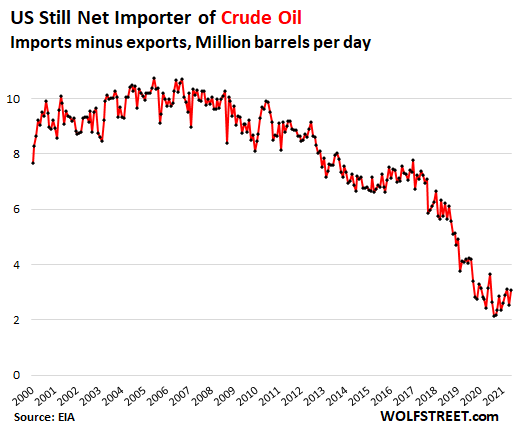
This new-found discipline in production, in a period of reduced demand, has helped push the price back up to a survivable level for the US oil patch. This discipline didn’t come easy. It was forced on the industry by a slew of bankruptcies and by battered investors who had had enough with the philosophy that they needed to fund production growth at any cost.
A similar scenario is playing out in the US natural gas sector, where production is still down, exports are booming, and prices have been rising. Read… Fracking Suddenly a True Believer in “Discipline?” US Natural Gas Net Exports Hit Record, Prices Jump as Production Stalls
Enjoy reading WOLF STREET and want to support it? You can donate. I appreciate it immensely. Click on the mug to find out how:
![]()


You are missing a vital point. Oil is not equal to oil. There’s light sweet and heavy oil. And it has to be refined. All the oil in the world does not help you if you cannot refine it.And the U.S. cannot refine its cracked oil. That’s why they have to export it. And import the stuff that they can refine from none other than russia. And they will never ever be able to compete with russian and canadian and mexican prices. Never.
Fracking is just another Wall Street scam.
Please elaborate for me, as I’m confused. The U.S. is dependent on Russian oil because we can not further refine are own crude oil using a process that we (U.S.) helped pioneer since the 1920s?
Exactly.
The fracked oil is light “sweet” crude oil since it contains only small amounts of sulfur. The U.S. refineries are built for “heavy” oil. That’s why the world is awash in light sweet oil right now, but the U.S. can’t use it. They have to import the heavy oil their refineries can turn into gasoline, kerosine and so on. That oil comes from russia, Canada and Mexico mainly.
No… just no. In point of fact what the U.S. exports the most of (according to the EIA) is Gasoline and “Hydrocarbon Gas Liquids.” Meaning we refined it and then we shipped it. In fact MEXICO and CANADA are our two biggest export markets.
The U.S. has been refining the heaviest of heavy crude at its Gulf Coast plants for a very long time… that is why Venezuela (at least under Chavez) was always careful to not cross the line beyond anti-American rhetoric.
and yet merika IMPORTS MORE GAS than it refines
these ‘producers’ are MIXING epa CRAP-ethanol, etc.
not cracking like it used to
think we have under 5 proessors left
I am not sure what you mean by that. America exports far more “Finished Motor Gasoline” than we import. About four times as much currently. But that is just a drop in the bucket compared to how much gasoline we refine from crude oil.
What we do import a lot of is “Motor Gasoline Blending Components”… whatever that is. And obviously we hardly import fuel ethanol at all.
“Hydrocarbon Gas Liquids” means Natural gas, mostly liquified.
That has nothing at all to do with oil. And it is actually really dumb to export it instead of using it in the U.S. But hey, dumb is as dumb does.
No. Natural Gas is different. So is LNG.
From the EIA, HGLs are categorized chemically as
– Alkanes, or paraffins (Ethane, Propane, Butanes: normal butane and isobutane, “Natural gasoline” or pentanes plus
-Alkenes, or olefins (Ethylene, Propylene, Normal butylene and isobutylene)
Basically they are BYPRODUCTS of refined crude oil and natural gas. They account for about 15% of U.S. petroleum usage.
Franz Beckenbauer,
“Hydrocarbon Gas Liquids” means Natural gas, mostly liquified.”
Nonsense (also, you misspelled “liquefied,” which is always a bad sign).
“Natural gas” = CH4. Liquefied natural gas (LNG) has the same chemical formula, but has been liquefied by a cooling process.
“Natural Gas Liquids” are not “natural gas.”
For your education, so that you won’t keep posting this nonsense here, they are a group that includes the below. Each has its own uses and markets. Some of them you may use around the house or camping, in cans or bottles, such as propane and butane.
Ethane (C2H6)
Propane (C3H8)
Normal butane and isobutane (C4H10)
Natural gasoline or pentanes plus (C5H12)
Ethylene (C2H4)
Propylene (C3H6)
Normal butylene and isobutylene (C4H8)
Stick to soccer.
Franz, you are completely off base.
Historically, refinery capex went towards heavier crude, and the U.S. is indeed struggling to refine the shale oil because of legacy refineries. So what? Is shale fundamentally unrefineable? That’s just nonsense. Light crude is actually easier to refine, distill and transport.
If light sweet is so easy to refine, why doesn’t the U.S. do it ? And still import the stuff from russia, canada and mexico mainly ? Which, by the way, is dirt cheap compared to fracking oil ? Which makes the whole thing quite absurd, economically.
Because that’s not what this is all about. This is just about Wall Street pumping an idea, paying politicians to sound off on “energy independence” and “new technology” and make tons of money financing the deals.
Refine has two definitions.
1) A synonym for distilling
2) making finished product. Like diesel or gasoline.
1) is easier with lighter crude because the lightest molecules are the first which are separate when you distill. But 2) is harder. If you finished product needs around 20 carbon atoms per molecule and your light crude only has around 6 atoms than you need to stitch oil molecules together and that is hard.
Franz Beckenbauer,
Red herring, been said for years, been nonsense for years. Read the article and look at the crude oil by itself that the US exports.
So here is something for you to know: The US West Coast and the vast California economy are cut off from US producing regions. There are no crude oil pipelines across the Rockies. California produces some oil, and imports some from Alaska by tanker, and some by oil train (hauling an oil train across the Rockies makes for expensive crude oil), and they import the rest by tanker from other countries.
California refines that crude oil, including the imported crude oil, and then exports gasoline and diesel to Latin America. It’s a big business. I see those tankers head out from the Bay Area refineries all day. That’s why California imports crude oil and exports gasoline. And that’s why there continue to be large imports of crude oil because that’s the way the US West Coast gets much of its oil.
Crude oil that is produced elsewhere needs to be pumped by pipeline to markets, but then you run into the problem that the producing areas are not well connected to all the areas where these products are needed. There is a mismatch. Including with the West Coast. Imports to here and exports from there help balance this out.
The surge in production has come so fast that the pipelines haven’t caught up. It takes a long time to build a pipeline.
West Coast refineries: what Wolf says is an ironic/humorous fact. There are lots of refineries in CA- well hidden, such as in the Martinez hills. Californians love their gasoline, but don’t want you to know. They’ll even make enough to export if you want.
California has a lot of problems related to poor management of population growth and the real economy (they are related)- too much traffic, not enough water, distorted tax base, failing public schools, etc., etc., etc.
California’s problems all come done to house policies.
Many players hedged their selling prices, and so to varying degrees are not participating in the upside and not particularly incentivized to increase production.
Of course that seemed like a genius move when prices collapsed in Q1 2020 but now, not so much.
There’s an article on oilprice dot com titled “Shale Giants Hit Hard By Poor Hedging Decisions” which suggests that because of swap contracts, current high prices are not translating to additional cashflow for many of the shale producers. That cashflow would otherwise have been put to work increasing production.
There’s less hedging of next year’s production, so if high prices continue into 2022, then we might see an increase in drilling again.
Franz. The US does not refine oils? I’d need some citations there. As far as I know there are refineries all over the place in the states. Did they shut down and haven’t started up again yet? Venezuela screwed itself by not building out its own refinery capacity. It shipped its oil to the US for refining.
Of course the U.S. refines oil. Lots of it. But mainly the “heavy” type for two reasons:
1. The refineries were originally built for that type of oil, and changing the refinement process is expensive.
2. The “heavy” oil imported from canada and russia is dirt cheap – compared to fracking oil – and allows the refineries to operate at a profit. That’s why the U.S. will be an importer of oil forever: It’s the only way to make the whole thing halfway profitable.
Venezuela screwed itself by building refineries using American/Western tech. America blocks the export of spare parts. This would have hit Western oil supply companies in the future but oil is a dying industry anyway so does not matter.
In 2020, oil refinery capacity in the United States amounted to approximately 18 million barrels per day. Although refineries are operating at full capacity, they may still have difficulties in meeting daily energy demands.
Oil consumption will rise : Lcc-20 Mount Whitney, HMS Queen Elizabeth, Carl Vinston with 65 F35C and Osprey, Ozie sailors & the Japanese
will visit Putin & Xi.
1) Global oil demand fell 10% more than 9M bpd to 88.5M bpd in 2020.
2) US demand : (-)11.8%, China : +1.6%, Canada : (-)10%, Japan : (-)11.4%
and in Germany demand was down 9.9%.
3) US is still top crude oil producer : 11.3M bpd, 15% of the global production, but
down 7.6% in 2020.
4) Russia production : 10.2M bpd, (-)9% in 2020.
5) Saudia : 9.4M bpd, (-)7%.
6) Canada : 4.5M bpd, (-)4.7%.
7) US is also top producer of NatGas, LNG, NGL and BML…
I think the hedging information is really interesting. It means that once again the Saudis have the absolute best intelligence on the world’s oil markets of anyone out there. There is no way that they would have increased the price of oil by 80% in six months without that knowledge.
That said, the Saudis have clearly spent the past seven years trying to discipline the American financial markets into treading carefully where the frackers are concerned. Wolf talked about “investors” but the ones who can put a kibosh on new rigs are the oil patch “bankers” who need to see that the price of oil will STAY high before they go chasing that rabbit again.
From $2.75 during pandemic to $5.25 as of today, the gas price , per one gallon of gas is much higher than prepandemic of $4 in los angeles
If the oil and gas prices were negative, angelinos would still pay a dollar per gallon at the pump
So technically it’s almost like paying Europeans for gas. The advantage is that it drives adaption on EV. Which is good except CA hasn’t set up everything around the transition.
The good thing is EV pricing is down sufficiently so more people can afford it.
EV adoption is great because it makes ❤dirty Diesels❤ cheaper for me!
I paid 2.67/gallon at Costco yesterday.
Is that in CA? If so, curious as to where. The Bay Area Costco breached $4 about two weeks ago.
Between EV’s and shale, looks like
America 1 – Energy Problems 0
1) US+ Canada 1:0 Energy problems, but if the TM pipeline will export to China…US will sneeze !!
2) Our blood pipeline transmit antibody to every part of the body. Vaccinated people are protected, but the nose, with less capillaries, isn’t !!
3) Vaccinated people might transmit covid when they breath/ sneeze.
4) Muzzled nose might protect other people.
The push for shale always seemed to have a geo-political element that was largely ignored by the press. Reduce American and other country dependence on middle eastern oil and that reduces the economic chokehold potential. Less uncertainty, better balance of trade and more pliable sheiks help sweeten the deal. Not a long-term play in the US, but we had the capacity to pursue that policy.
China is dealing with a highly contagious respiratory virus in numerous provinces.
Florida set a new record for COVID hospitalizations. Texas and Florida are less than 50% fully vaccinated.
Some recreational use of gasoline and jet fuel might be reduced.
Canada, Argentina and China are fracking. Saudi Arabia may be setting up fracking with seawater. Other nations are investigating fracking as an option.
As a chemist from the oil patch I still talk to mud engineers that ain’t dead yet. Fracked wells will start cycling into zero production due to depletion from porosity collapse. Fracking Do overs ain’t happening .If the Fed will give them free money they will frack a grapefruit. Outside of the Fed good luck. The Bigs will stay the Bigs and have absorbed any fields that may have durable production for pennies on the dollar. The Bigs old legacy wells were capped and welded shut. At $100 a barrel they will pop the top and pump $1 oil and sell. Saudia Arabia or whom ever has the oil if be-headings start will still have still have free oil oozing out of the sand. The House of Saud is tickled pink that the almost 100$ billion a month trade deficit the US has with China is fueled by Saud Oil. They are not on the hook. China stands between the U.S. and them. The House of Saud remembers painfully the Kissinger and “Generalissimo” Al Haig and Solemn Bros. gun slinger shake down they got in the 70’s over the oil trade deficit and gold drain with the U.S. in which Tricky closed the gold window and gave the world the fiat federal reserve note petro dollar. The Americans wanted gasoline not sound money. The Kingdom was forced to take our stinking pile of debt or well…….you get the drift. As the most brilliant Nobel Economist of our time ,Paul Krugman, pointed out . The dollar is (now) backed by men with guns. The House of Saud is grinning ear to ear on their 9.5 MPD sales in the shadow of China. Our Bigs always get lean and mean and during a crisis. When they bust a move after the market crashes get on board for dividends plus growth. I love Big Oil. If you want fertilizer to keep you eating you can learn to love Big Oil too. Battery lovers can learn to love Big Oil too. Big Oil will be providing you the juice for your beloved batteries.
bs : ARAMCO was confiscated in 1973, one step at a time, to punish the infidels who discovered, developed and gave jobs to Saudi’s engineers, from US big 4.
King Faisal pd the price in 1975, using his hateful nephew.
1 barrel of oil has the energy content of 5 BTU. Oil will not be used to recharge batteries unless it drops to very cheap prices.
NG Futures weekly : between 12/12/2005 and 6/30/2008 there is a swing point @ 4.05 in 9/25/2006. This is where NG is.
Since 2013 lower highs/ lower lows.
Thanks once again for your insights, etc., ME!
And gotta say, after reading your many posts since we have been on here trying to understand and figure out if we can/should start investing in the SM again after 40 years out of that market in favor of the RE mkt,,,
You have become much more ”legible” recently, though, far shore, I was formerly/eventually able to decipher your previously mostly ”shorthand”/etc., or at least somewhat to my satisfaction.
Thank you,
Could some production decline be due to depletion, not planning?
No. There is plenty of this stuff left for now. And there are many thousands of drilled but uncompleted wells that are just waiting to be completed and start producing. The industry can ramp up production at lightning speed, and has done so before.
The persistent theme in the US policies in regards to the Energy Sector is the lack of long term policies, which further undermines the recovery efforts of any cohesive Economic turnaround.
This contrasts wildly with all the continued assertions of the consecutive American administrations to a concrete commitment to secure the future energy for this country!
As you know, energy is what keeps the economy humming, and the security of maintaining a reasonable price for a reasonable unit of produced energy should NOT be underestimated in importance to the continued functioning society.
It is very easy to dismiss the losses incurred in a vital sector, like the energy sector as a well deserved punishment for self inflicted disaster, and move on to strip the next bush of it’s produce and keep the party going.
However the repercussion of sinking large amounts of energy and capital should be looked at a little bit more seriously than a mere gloating opportunity to prove a point or win an argument.
Energy sources from fossil fuels are looked at as the pariah and found to be easily criticized,
with No clear alternatives being proven to power the large economies of the world as they stand at this moment of history,
( you need to look at the real statistics here to overcome the urge of a hubristic calculations of the “climate change industry cohort “).
While I detest the cartel like mentality of oil producing countries, one must recognize that the large American technology companies( and pharmaceutical , or any other sector for that matter),don’t exactly give their products free of charge either! and are regularly screwing the tax payers for decades on end when their patents looks like a never expiring fountains of gold!!
A fair price for a fair product is always a function of a mature market ( free of manipulations),
To suggest that a certain country wether producer or consumer have the right of manipulating the product is a killer mistake that many countries’s leaders fall into and find out to great cost to their economies and pain to their populations ultimately in time.
A Not so clear mandate to achieve an economic growth and recovery is in the hands of a congress that barely resembles any picture of leadership that this country have managed in a 100 years.
As such it is really early ( or very late in some respect depending on where you stand in the climate argument ), to judge the lack of a decisive and detailed progress to transform our economies skeletal core to a non carbon or carbon neutral based economy.
The less than constructive debate in Congress lately( the current bill represents only one fifth of the promised 2.2 trillion dollars promulgated by the Democrats and spinned as the panacea , and a clear cut road of to normal economic output).
in regards to these very issues it’s all but clear to see the drag and mishandling of 100’s of billions of dollars of the taxpayers money with No demonstrable benefit to advance our transformation to a less fossil fuel dependency , and to take the country into the midpoint of this century.
And how to combat China’s drive to win the race into a managing the challenges that our o species face going forward.
Do you know why treasury yields are barfing like crazy? 10yr at 1.16% despite 5%+ inflation and 6%+ GDP growth?
Despite Delta, no major US politician is suggesting more lockdowns. If this holds, the impact on the economy will be limited.
Is this the taper tantrum in response to the upcoming QE reduction? In 2013, bond traders reacted by dumping bonds & sending interest rates sharply higher. Since Wall Street has now been conditioned to believe the Federal Reserve will always save them if s—- hits the fan, they do the opposite instead?
They frantically buy up long term treasuries to flatten the yield curve, knowing the FOMC would never dare to invert it. The flatter yield curve also sends a downbeat economic signal, making the FOMC think twice about tightening. Something similar happened in 2018 when markets were upset about what they saw as excessive tightening.
Is this it? The $80 billion in monthly QE (a small fraction of which is in 10+ yr bonds) isn’t enough to drive down yields by this much.
Long bond market is smart and knows economy is too debt encumbered to grow. Buffet is smarter and holds $140 billion t-bills. He purchases a forever equity in a recession and locks in a high return on that capital. Investing in a high single digit utility or railroad looks pretty smart now. Very long term investment s should be stocks, but you have to buy at right price which isn’t now.
QE has a huge amount to do with it. There was/is also a mega-short squeeze. Shorting the 10-year Treasury was considered the biggest no-brainer in the history of mankind, and it was until it suddenly wasn’t. Some big hedge funds are now taking big losses. There are other factors involved too.
Discipline, hmmm …
It’s hard to start up a well after it’s been shut down, it usually has to be reworked to some degree. Also there are wells ‘drilled and uncompleted’ (DUCs) that also need time and material to get the oil flowing.
Also, fracked plays have very steep decline rates with constant/increasing drilling/completing new wells to keep up with depletion in legacy plays. It is going to be interesting to see if drillers — after significant consolidation in fracking industry and standoffish ‘investors’ — can catch up.
Right now it looks like they can’t.
I think one of the issues facing the U.S. petroleum industry is the number of fracking acreage that hasn’t already been consumed. Check out this interesting chart. The big takeaway is that the Permian seems to be the last region still actively growing. Look at the 3yr chart. https://oilprice.com/rig-count
1) Thousands of DUCs quacked to attract.
2) Hundreds of billions poured to the shale brigades without bullets or guns.
3) The good stuff is gone. The hard to extract is deep underground, on the maps, to extract.
4) The sitting ducks investors didn’t know that WTI have to go to higher level to justify actions, at prices consumers cannot afford, WITHOUT gov supporting consumers, the whales, or both of them, to keep US strong.
5) The shale whales will swallow the guppies with gov approval.
6) The gov will partner and dominate them, collect voters and dividends.
Yikes! We’ve got into the most complex multi-player chess game on the planet. Every move by every player is pondered and dissected in minute detail.
The market price is obviously key, and that’s why it’s a main news item every day. The other key factor for all the players, as I recall it, is the breakeven cost of production. I’m too lazy to look up current figures but my very rough recollections from a hazy memory go roughly, Saudi$14, Russia$30 US fracking$55.
Don’t quote me, but you get the picture, Saudi could wipe everybody at $15 but they would need every ship in the World and would only make a $ a barrel. Not going to happen so they divi up, and discuss and negotiate who their friends are. The price is set so they all get their agreed share of the money. Covid knocked demand bigtime so the price collapsed and they had to renegotiate supply shares to get where we are now, which marginally brings some of the cheaper frackers back into the game. Countries have all got their own problems and need their oil revenues desperately. Hence the recent hoohah over shares between Saudi and UAE. Imagine the US deficit without that home produced oil?
When USA ran the World, everybody did what they were told or they got the Hell bombed out of them, but that doesn’t work anymore due to China and Russia.
I just pay the price at the pump and drive off, it’s easier than worrying about it.
Russian costs are in rubble, not dollar. They will drop the exchange rae between dollar and rubble when the oil price is low in dollars. US and Saudi can’t do that because their costs are also in dollars
I don’t leave links .. because when I receive them .. I never get around to looking at them & therefore it is a reasonable assumption that others don’t either.
State Solar Program
solargroup-australia.com.au
Australian Homeowners Are Checking Their Postcodes For Update Programs.
Power companies are fighting an uphill battle they are sure to lose & they are blaming customers who are taking advantage of massive government saving programs.
Specifically, they are blaming rebates & interest free financing that incentivise homeowners to use clean energy by offering a new solar installation with no money out of pocket & up to $7,000 in rebates.
THIS IS A BLATENT LIE ..
POWER COMPANIES WILL NOT HAVE TO OUTLAY MEGA MILLIONS TO BUILD NEW POWER PLANTS .. THE SOURCE IS NO THE ROOFTOPS OF CITEZENS HOMES .. AND FOR THE MOST PART .. THE FREE IS TO BE SOLD ON TO THE CUSTOMER AT TOP DOLLAR PRICES
= PROFIT WITH NO OUTLAY OF CAPITAL ON THE PART OGF THE POWER COMPANIES.
This plan is equal to a mobile phone plan .. or the way my parents purchased a fridge .. with no deposit & monthly payments .. where is it anything new.
In fact .. the clever than thou power companies have convinced the feeble minded government to pay for the set up .. with .. HARD EARNED TAXPAYER DOLLARS.
Yes folks .. pay day they are all over us like a rash for a reason.
We the people of planet earth get to pay for everything.
“SOLAR WILL BE THE SINGLE LARGEST SOURCE OF ELECTRICITY IN THIS GENERATION” – ELON MUSK.
I have been banging this drum for the past 40 years ..
Elon Musk is only 50 years old.
Elon Musk has somehow come out the brilliant hero based on my business concepts ..
I saw solar power as a great business PROFIT for the power companies .. utilising the roof tops of the citizen to generate free energy .. to sell on at top dollar profits .. while saving millions in outlays & lastly as a clean energy.
?
?\,,
Oh,
Oops,
I forgot to say,
The filthy rich power companies, benefiting from poor spending decisions on the part of the Australian governments, in the midst of a national pandemic crisis, where unemployment is massive & business is almost non existent
Have Decided .. TO Put Up the Prices Of the FREE Energy they are getting from said customers ..
From the 1st August we the people of Victoria have been smacked with a BIGGER POWER BILL.
How’s that for gratitude.
A quick look at Wikipedia reveals that, in 2018, the US consumed 20mm bbl/d and produced 12 mm bbl/d. that means we imported 20-12 = 8, so where des Wolf get his charts from? Are these figures from
Wikipedia mistaken?
Andrew Trupin
“A quick look at Wikipedia reveals…”
OK, stick to your “quick looks” at Wikipedia. Don’t come around here. You don’t understand what you’re “quickly looking at” BECAUSE YOU DIDN’T READ IT, neither in Wikipedia nor here. READ THE ARTICLE, AND THE SECRETS WILL BE REVEALED TO YOU.
All of the data in my article come directly from the US Department of Energy’s Energy Information Administration (EIA), as it says on each of my charts, which of course you didn’t see either because you’re only into “quickly looking at.”